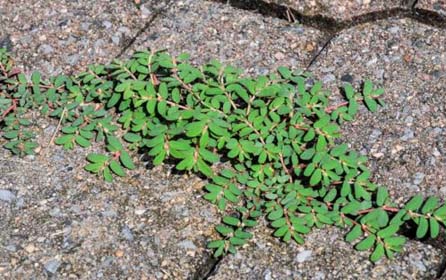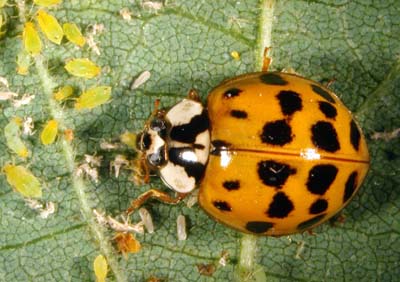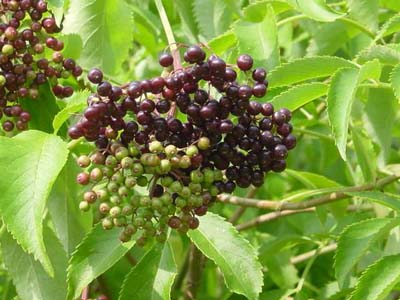The Good, the Bad and the Very, Very Bad
Check out these books about bugs, weeds, berries and mushrooms
By George Graine, Fairfax Master Gardener
“There’s nothing so good that there isn’t a little bad in it and nothing so bad that there isn’t a little good in it.” – Graine family quote
St. Lynn’s Press has published a novel series of four books you may find useful, each exploring its own subject — bugs, weeds, berries and mushrooms – and shedding light on its good and bad characters.
Each book is easy to use for anyone who likes to garden and wants to avoid some of the frustrations that are a part of this hobby. The contents are described below, but in general, they are all useful for the following reasons: First, each is a compact size (6”x7”), small enough for use as a field guide. Second, all are spiral-bound with matte-laminated, heavy-stock pages and color photos for each subject. And, third, the written descriptions are succinctly noted on every page without a lot of horticultural jargon.
Good Weed — Bad Weed: Who’s Who, What to Do, and Why Some Deserve a Second Chance
by Nancy Gift (2011).
Weed books are often difficult to comprehend, sometimes intimidating. Often these books are so full of information that you might say something like, “Help, I’m getting lost in the weeds!” Do not fear because this author has written a very different kind of weed book. The book depicts in color 44 weeds (eight bad, eight not-so-bad, and 28 good) and describes life cycles, benefits or drawbacks, and best method of organic control (often by pulling or using a dandelion prong). Additionally, each weed is indicated by season of the year.
You may have heard the expression that a weed is a plant out of place, but it is not absolutely necessary to kill every weed. An example of a “good” weed is clover. (Please don’t sigh.) This weed contributes nitrogen to the soil; therefore, less fertilizer is needed. Furthermore, clover is not part of the lawn-grub (bad guy) diet, so that means less reliance on control. Contrast clover with the annual “bad” weed –- crabgrass. If allowed to survive, this weed will produce a zillion seeds that could eventually out-compete turf. By applying a pre-emergent control at the proper time, you will often smother most of the potential crabgrass seedlings before they erupt.

Prostrate spurge
So. . . how about the next time you see a dandelion (good weed?); will you enjoy the flower, or use the young leaves in a salad, or have your children blow the fluffy, round seed-head? By the way, in general, if your turf is very healthy and without bare ground and mowed high (3 inches), it will usually discourage most weeds. Whether you agree or disagree on the categories of bad, not-so-bad, or good weeds, you will definitely learn a lot from this book.
Good Bug — Bad Bug: Who’s Who, What They Do, and How to Manage Them Organically
by Jessica Walliser (revised 2011)
Bugs/insects –- love ‘em or kill ‘em. Are they good or evil? This text includes 54 pages of pests and 27 pages of beneficial insects. It is incumbent on all of us to know the good from the bad. Many people do not recognize this difference, and this is truly unfortunate. This book is a necessary addition to your horticultural toolbox. The author provides easy-to-follow, proven and simple strategies to cope with the “evil” critters and how to recognize the good guys. Put in simpler terms, the Good Bug-Bad Bug book is a hands-on guide that will help sort out who’s who. To help understand some technical terms, a garden glossary is included, as well as information on organic products that are often available at full-service garden centers.

Mature lady beetle confronts aphids, a favorite meal.
This may sound like an easy fix to your insect problems, but the fact remains that insects will always be with us. Your job is to try to reduce the bad population by using the safest and most effective solution. In the current idiom, may the force be with you.
Good Mushroom — Bad Mushroom: Who’s Who, Where to Find Them, and How to Enjoy Them Safely
by John Plischke III (2011)
Mushrooms: you have seen them in the lawn, growing on dead or dying trees, and, of course, in the grocery store. Mycologists (the folks who spend time studying mushrooms) tell us to be wary of mushrooms unless you can differentiate the good (edible) from the bad (inedible or poisonous).
Plischke, an expert mycologist, helps to distinguish the difference between various types of wild mushrooms in order to avoid dire consequences. He guides us to 26 edible mushrooms and their poisonous look-alikes. He also identifies 11 mushrooms you should avoid. A poisonous mushroom may not harm you immediately; however, some poisonous mushrooms can build up toxins in your body until you end up in another place –- permanently. If you are the outdoorsy type and curious about the mushrooms you find, the author has gone to great lengths to explain how to avoid potential danger. In fact, you may be surprised that he recommends that you purchase other field guides to aid you and to go on a mushroom hunt with someone who is an expert. Simply put, cross-checking everything should be a cardinal rule. Aside from an abundance of good information about mushrooms, the author has provided eight of his own recipes for cooking with wild mushrooms. His website http://home.comcast.net/~grifola/site/ contains more recipes.
And finally, one last caution. If you are not absolutely sure of the identification of a mushroom, then follow the admonition of “when in doubt, throw it out.”
Good Berry — Bad Berry: Who’s Edible, Who’s Toxic, and How to tell the Difference
by Helen Yoest (2016)
This is a very good read for the adventurous gardener or naturalist. (Note: In botany, a berry is defined as any fruit that has its seeds enclosed in a fleshy pulp.) Let’s assume you and a friend take a walkabout in the woods, and you find some berries on a shrub or tree. Should you stop to eat them? If you saw a bird eating berries, would you follow suit? Do you know a good berry from one that does not taste good, or — worse yet — could land you in the ER? Many of these questions and explanations are answered in the Good Berry-Bad Berry book. In addition to what is considered good or bad for human consumption, the author includes an intermediary section. In essence, this means that berries that are not poisonous are also not necessarily edible. If a berry tastes bad, you should immediately spit it out, rinse your mouth with water, and seek medical advice.
Only 40 berries are discussed in detail. Many other berries are simply listed as good or bad by name and where they usually grow by region. The book does not include the grocery-store berry varieties, such as strawberries, blueberries or raspberries.
Of the 40 berries discussed in detail, 13 are in the bad category. Most of these berries are common and probably familiar to you. All of them are mildly toxic to poisonous. These include:
| Oriental bittersweet Solomon’s Seal Cotoneaster Aucuba Nandina domestica Strawberry bush Common Honeysuckle (nectar OK) |
St. John’s Wort Ligustrum (Japanese privet) Virginia Creeper Rohdea (Nippon lily) Winterberry Holly Pokeweed |
The author discusses seven berries that will not kill you but are not worth eating. The list of inedible but not poisonous berries is probably familiar to you, and you may have some growing on your property.
| Coralberry Hawthorn Mayapple Poet’s laurel |
Porcelain vine Pyracantha (Sweet firethorn) Yew |

Partially ripened cluster of elderberries
If you are hiking in the woods, you should avoid all vine fruit. If you are walking or biking alongside a road and spot some berries among dead foliage, do not eat the berries. Chances are a road crew sprayed the foliage with herbicide and left a poisonous residue on the berries. By chance if you eat a poisonous berry, call 911 or the National Poison Control Center at 800-222-1222. If your pet ingests a poisonous plant, contact your vet or the ASPCA Animal Poison Control Center at 888-426-4435. It is better to be safe than sorry.
George Graine is an award-winning garden writer. He often writes under the pen name, Grainethumb.